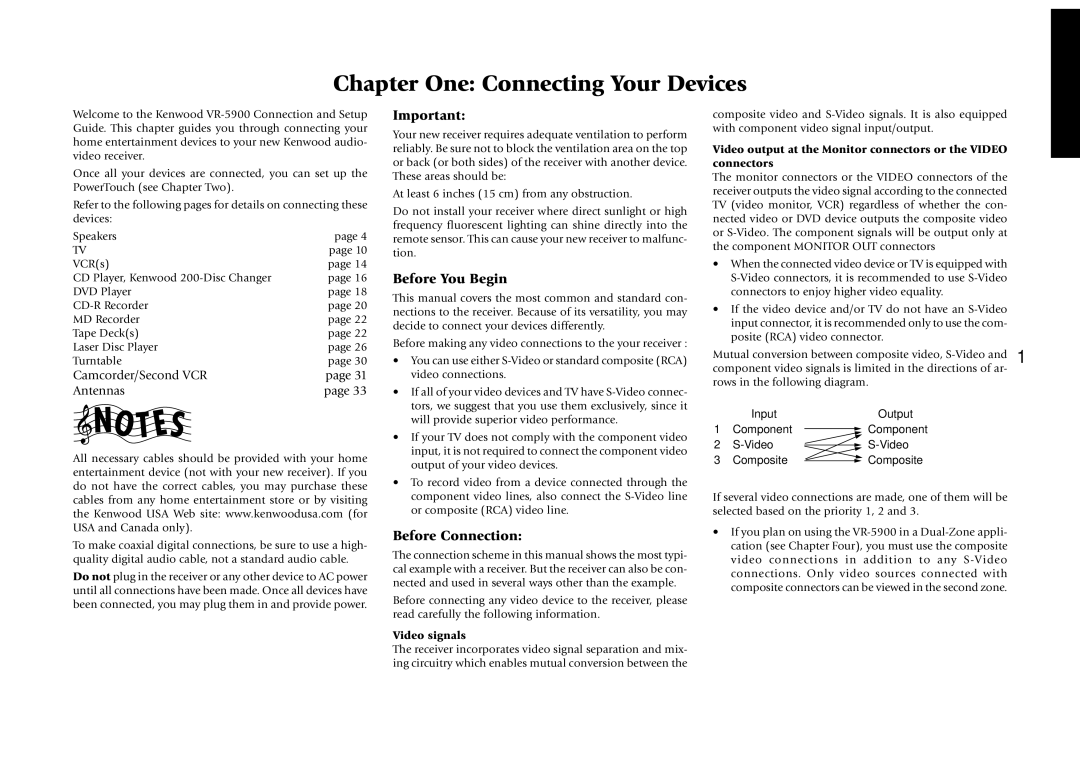
Chapter One: Connecting Your Devices
Connections
Welcome to the Kenwood
Once all your devices are connected, you can set up the PowerTouch (see Chapter Two).
Refer to the following pages for details on connecting these devices:
Speakers | page 4 |
TV | page 10 |
VCR(s) | page 14 |
CD Player, Kenwood | page 16 |
DVD Player | page 18 |
page 20 | |
MD Recorder | page 22 |
Tape Deck(s) | page 22 |
Laser Disc Player | page 26 |
Turntable | page 30 |
Camcorder/Second VCR | page 31 |
Antennas | page 33 |
All necessary cables should be provided with your home entertainment device (not with your new receiver). If you do not have the correct cables, you may purchase these cables from any home entertainment store or by visiting the Kenwood USA Web site: www.kenwoodusa.com (for USA and Canada only).
To make coaxial digital connections, be sure to use a high- quality digital audio cable, not a standard audio cable.
Do not plug in the receiver or any other device to AC power until all connections have been made. Once all devices have been connected, you may plug them in and provide power.
Important:
Your new receiver requires adequate ventilation to perform reliably. Be sure not to block the ventilation area on the top or back (or both sides) of the receiver with another device. These areas should be:
At least 6 inches (15 cm) from any obstruction.
Do not install your receiver where direct sunlight or high frequency fluorescent lighting can shine directly into the remote sensor. This can cause your new receiver to malfunc- tion.
Before You Begin
This manual covers the most common and standard con- nections to the receiver. Because of its versatility, you may decide to connect your devices differently.
Before making any video connections to the your receiver :
•You can use either
•If all of your video devices and TV have
•If your TV does not comply with the component video input, it is not required to connect the component video output of your video devices.
•To record video from a device connected through the component video lines, also connect the
Before Connection:
The connection scheme in this manual shows the most typi- cal example with a receiver. But the receiver can also be con- nected and used in several ways other than the example.
Before connecting any video device to the receiver, please read carefully the following information.
Video signals
The receiver incorporates video signal separation and mix- ing circuitry which enables mutual conversion between the
composite video and
Video output at the Monitor connectors or the VIDEO connectors
The monitor connectors or the VIDEO connectors of the receiver outputs the video signal according to the connected TV (video monitor, VCR) regardless of whether the con- nected video or DVD device outputs the composite video or
•When the connected video device or TV is equipped with
•If the video device and/or TV do not have an
Mutual conversion between composite video,
InputOutput
1 Component  Component
Component
2 |
| |
|
3 Composite  Composite
Composite
If several video connections are made, one of them will be selected based on the priority 1, 2 and 3.
•If you plan on using the
